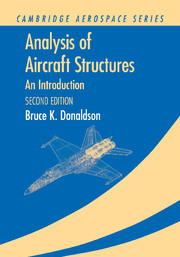Book contents
- Frontmatter
- Contents
- Introduction to the Second Edition
- Introduction to the First Edition
- List of Repeated Engineering Symbols
- Acknowledgments
- Part I The Fundamentals of Structural Analysis
- Part II **Introduction to the Theory of Elasticity**
- 7 The Theory of Elasticity
- 8 Plane Stress Theory of Elasticity Solutions
- Parts I and II Review Questions
- Part III Engineering Theory for Straight, Long Beams
- Part IV Work and Energy Principles
- Part V Energy-Based Numerical Solutions
- Part VI Thin Plate Theory and Structural Stability
- Appendix A Additional Topics
- Appendix B Selected Answers to Exercises
- References
- Index
8 - Plane Stress Theory of Elasticity Solutions
from Part II - **Introduction to the Theory of Elasticity**
Published online by Cambridge University Press: 05 June 2012
- Frontmatter
- Contents
- Introduction to the Second Edition
- Introduction to the First Edition
- List of Repeated Engineering Symbols
- Acknowledgments
- Part I The Fundamentals of Structural Analysis
- Part II **Introduction to the Theory of Elasticity**
- 7 The Theory of Elasticity
- 8 Plane Stress Theory of Elasticity Solutions
- Parts I and II Review Questions
- Part III Engineering Theory for Straight, Long Beams
- Part IV Work and Energy Principles
- Part V Energy-Based Numerical Solutions
- Part VI Thin Plate Theory and Structural Stability
- Appendix A Additional Topics
- Appendix B Selected Answers to Exercises
- References
- Index
Summary
Introduction
Chapter 7 illustrated the direct approach to solving selected problems in structural mechanics. In that chapter solutions for structural displacements and stresses were obtained through the separate use of the four sets of equations that constitute the theory of elasticity. There were no major difficulties in solving the example problems of that chapter because the original three-dimensional problems were reduced to one-dimensional problems (i.e., problems involving only one independent spatial variable) by means of plane stress and symmetry concepts. More challenging problems are the theory of elasticity problems that involve two independent spatial variables, such as plane stress problems in general. The purpose of this chapter is to present two of the simplest of such problems and their solutions in order for the reader to obtain some familiarity with their characteristics. The selected example and exercise problem solutions of this chapter are sufficiently valuable to be referenced in succeeding chapters as proof of the accuracy of the approximations adopted in those chapters.
While the followinge theory of elasticity solutions provide valuable practice in all the essentials of structural engineering analysis, it is also important to know that from the point of view of everyday structural engineering practice, theory of elasticity solutions are rarely, if ever, referenced. The advent of modern digital computers and the development of modern numerical methods, particularly the finite element method that is explained in Part V of this textbook, have relegated theory of elasticity solutions to the role of mere curiosities.
- Type
- Chapter
- Information
- Analysis of Aircraft StructuresAn Introduction, pp. 192 - 210Publisher: Cambridge University PressPrint publication year: 2008



